Serpulidae
The Serpulidae are a family of sessile, tube-building annelid worms in the class Polychaeta. The members of this family differ from other sabellid tube worms in that they have a specialized operculum that blocks the entrance of their tubes when they withdraw into the tubes. In addition, serpulids secrete tubes of calcium carbonate. Serpulids are the most important biomineralizers among annelids. About 300 species in the family Serpulidae are known, all but one of which live in saline waters. The earliest serpulids are known from the Permian (Wordian to late Permian).[1]
| Serpulidae | |
|---|---|
.jpg) | |
| Spirobranchus giganteus is a species of tubeworm belonging to the Serpulidae family. Note the yellowish cartilaginous operculum extending from the branchial stalk. | |
| Scientific classification | |
| Kingdom: | |
| Phylum: | |
| Class: | |
| Order: | |
| Suborder: | |
| Family: | Serpulidae Rafinesque, 1815[2] |
| Genera | |
|
see text. | |
The blood of most species of serpulid and sabellid worms contains the oxygen-binding pigment chlorocruorin. This is used to transport oxygen to the tissues. It has an affinity for carbon monoxide which is 570 times as strong as that of the haemoglobin found in human blood.[3]
Empty serpulid shells can sometimes be confused with the shells of a family of marine gastropod mollusks, the Vermetidae or worm snails. The most obvious difference is that serpulid shells are dull inside, whereas the molluscan vermetid shells are shiny inside.
Selected genera
- Amplaria Knight-Jones, 1973
- Anomalorbis Vine, 1972
- Apomatus Philippi, 1844
- Bushiella Knight-Jones, 1973
- Capeospira Pillai, 1970
- Chitinopoma Levinsen, 1884
- Circeis Saint-Joseph, 1894
- Crucigera Benedict, 1887
- Dexiospira Caullery and Mesnil, 1897
- Dextralia Knight-Jones, 1973
- Ditrupa Berkeley, 1835
- Eulaeospira Pillai, 1970
- Ficopomatus Sauthern, 1921
- Filograna Berkeley, 1835[4]
- Filogranella Ben-Eliahu and Dafni, 1979
- Filogranula Langerhans, 1884
- Galeolaria Lamarck, J.B. de (1818)
- Hyalopotamus Marenzeller, 1878
- Hydroides Gunnerus, 1768
- Janua Saint-Joseph, 1894
- Josephella Caullery and Mesnil, 1896
- Leodora Saint-Joseph, 1894
- Metavermilia Bush, 1904
- Neodexiospira Pillai, 1970
- Neovermila Day, 1961
- Nidificaria
- Paradexiospira Caullery and Mesnil, 1897
- Paralaeospira Caullery and Mesnil, 1897
- Pileolaria Claparede, 1870
- Placostegus Philippi, 1844
- Pomatoceros Philippi, 1844
- Pomatoleios Pixell, 1912
- Pomatostegus Schmarda, 1861
- Protolaeospira Pixell, 1912
- Protula Risso, 1826
- Pseudochitinopoma Zibrowius, 1969
- Pseudovermilia Bush, 1907
- Salmacina Claparede, 1870
- Semivermila Imajima, 1978
- Serpula Linnaeus, 1767 Type genus
- Simplicaria Knight-Jones, 1973
- Spirobranchus Blainville, 1818
- Spirorbis Daudin, 1800
- Turbocavus Prentiss et al., 2014[5]
- Vermiliopsis Saint-Joseph, 1894
- Vinearia
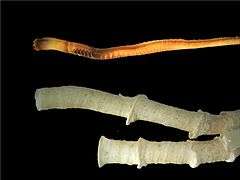
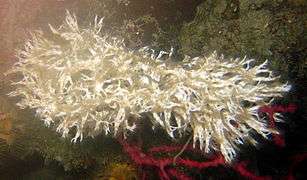 Filograna implexa
Filograna implexa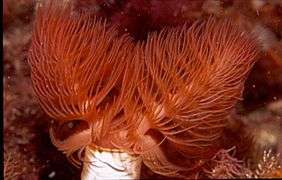
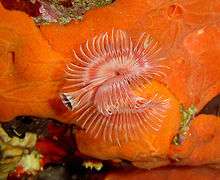

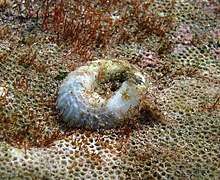 Spirorbis sp.
Spirorbis sp.
References
- Citations
- Rossana Sanfilippo; Antonietta Rosso; Agatino Reitano; Gianni Insacco (2017). "First record of sabellid and serpulid polychaetes from the Permian of Sicily". Acta Palaeontologica Polonica. 62 (1): 25–38. doi:10.4202/app.00288.2016.
- Read G, Fauchald K, eds. (2019). "Serpulidae Rafinesque, 1815". World Polychaeta database. World Register of Marine Species. Retrieved September 7, 2019.
- Cowles, David (2006). "Serpula vermicularis Linnaeus, 1767". Invertebrates of the Salish Sea. Rosario Beach Marine Laboratory at Walla Walla University. Archived from the original on 2011-10-02. Retrieved 2011-10-31.
- Read, G.; Fauchald, K., eds. (2014). "Filograna Berkeley, 1835". World Polychaeta database. Retrieved 2015-02-22 – via World Register of Marine Species.
- Prentiss, N.K.; Vasileiadou, K.; Faulwetter, S.; et al. (2014). "A new genus and species of Serpulidae (Annelida, Polychaeta, Sabellida) from the Caribbean Sea" (PDF). Zootaxa. 3900 (2): 204–222. doi:10.11646/zootaxa.3900.2.2.
- General
| Wikimedia Commons has media related to Serpulidae. |
- Abbott, R. Tucker (1986). Seashells of North America. St. Martin's Press.
- ten Hove, H.A.; van den Hurk, P. (1993). "A review of recent and fossil serpulid 'reefs'; actuopalaeontology and the 'Upper Malm' serpulid limestones in NW Germany". Geologie en Mijnbouw. 72 (1): 23–67.
- Ruppert, Edward E.; Fox, Richard S. & Barnes, Robert D. (2004). Invertebrate Zoology: A Functional Evolutionary Approach (7th ed.). Belmont, CA: Brooks/Cole – Thomson Learning Inc. ISBN 0-03-025982-7.